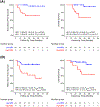Outcomes Stratification of Head and Neck Cancer Using Pre- and Post-treatment DNA Methylation From Peripheral Blood
- PMID: 36410685
- PMCID: PMC12272450
- DOI: 10.1016/j.ijrobp.2022.11.009
Outcomes Stratification of Head and Neck Cancer Using Pre- and Post-treatment DNA Methylation From Peripheral Blood
Abstract
Purpose: Established prognostic factors for head and neck squamous cell carcinoma (HNSCC) mostly consist of clinical and tumor features assessed before treatment. We report a novel application of DNA methylation in peripheral blood before and after radiation therapy to further improve outcomes stratification.
Methods and materials: Peripheral blood samples from patients with nonmetastatic HNSCC were obtained for methylation analysis 1 week before and 1 month after radiation therapy. Patients were randomized 1:1 to a Discovery Cohort or a Validation Cohort. In the Discovery Cohort, associations between genome-wide methylation change (posttreatment minus pretreatment) and recurrence-free survival (RFS) as well as overall survival (OS) were evaluated using Cox regression. A methylation risk score (MRS) was then constructed from methylation levels at the top associated sites, filtered for residing within the regulatory regions of genes expressed in cells of hematopoietic lineage. The prognostic value of MRS was separately assessed in the Discovery and Validation Cohorts.
Results: Between December 2013 and September 2018, 115 patients participated in this study. Human papilloma virus negative status, oral cavity cancer, gastrostomy tube insertion, and higher neutrophil count before radiation therapy were associated with shorter RFS and OS (P < .05). Genes downstream of the methylation sites comprising MRS are HIF1A, SF1, LGALS9, and FUT5, involved in hypoxia response, blood cell maturation, and immune modulation. High MRS (in the top third) was significantly associated with worse RFS (hazard ratio [HR], 7.1; 95% confidence interval [CI], 1.4-35.5; P = .016) and OS (HR, 15.9; 95% CI, 1.6-153.6; P = .017) in the Discovery Cohort, independent of the aforementioned risk factors. These findings were replicated in the Validation Cohort, for which high MRS also independently predicted worse RFS (HR, 10.2; 95%, CI 2.4-43.4; P = .002) and OS (HR, 3.7; 95% CI, 1.3-10.4; P = .015).
Conclusions: We successfully trained and validated a signature of DNA methylation in peripheral blood before and after radiation therapy that stratified outcomes among patients with HNSCC, implicating the potential for genomics-tailored surveillance and consolidation treatment.
Copyright © 2022 Elsevier Inc. All rights reserved.
Conflict of interest statement
Disclosures: A.H.M. reports being a consultant for Boehringer Ingelheim. K.A.H. reports other from AstraZeneca, grant funding from RefleXion Medical, and other from PrecisCa. N.F.S. reports being a consultant for GlaxoSmithKline, Merck, Bluprint, BioNTech, Kura, and Pfizer. All other authors have no disclosures to declare.
Figures




References
-
- Chow LQM. Head and neck cancer. N Engl J Med 2020;382:60–72. - PubMed
-
- Balermpas P, Rodel F, Rodel C, et al. CD8+ tumour-infiltrating lymphocytes in relation to HPV status and clinical outcome in patients with head and neck cancer after postoperative chemoradiotherapy: A multicentre study of the German cancer consortium radiation oncology group (DKTK-ROG). Int J Cancer 2016;138:171–181. - PubMed
-
- Bristow RG, Hill RP. Hypoxia and metabolism. Hypoxia, DNA repair and genetic instability. Nat Rev Cancer 2008;8:180–192. - PubMed
Publication types
MeSH terms
Substances
Grants and funding
LinkOut - more resources
Full Text Sources
Medical
Research Materials

